
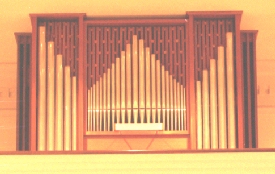
Unit Actions |
The term "unit action" can refer in its broadest sense to any one of several different applications in which a single rank can be controlled by more than one stop or a single pipe by more than one key. There are two applications of this principle, and two terms are used to more narrowly define the degree to which the process of sharing pipes is applied.
The term "duplex action" is applied to situations in which stops on different keyboards control a single rank of pipes. Duplexing offers advantages in terms of expense, in that a stop that is expensive to build - - a rank of large flues or reeds, for example - - can be used in more than one division, saving the cost of building a second rank of pipes.
On the other hand, duplexing has two disadvantages:
Duplex actions can be built for virtually any kind of chest and action, but the specific combination of mechanical elements present in an organ determines the way in which duplexing is accomplished. The different means used to duplex stops, or even whole divisions, use either mechanical or electrical methods to accomplish the task.
Mechanical transmission describes a process in which wind from more than one chest is conducted to a single pipe. The application of this procedure is found typically on mechanical- action instruments that use pallet and slider chests. It is generally used only in a limited way, to allow a rank of pipes to be played by two keyboards that control separate chests. A 16' Prestant, for example, might be available both as a stop on a Pedal division and as a stop on the Great.
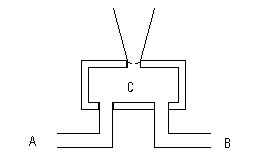 The most common means of
accomplishing this is to place conduits on each chest, in the places where pipes
would normally
stand. The conduits then lead to a common point where the pipe is actually placed, a
separate
channel being provided for each pipe that is included in the transmission. The
diagram to the right
illustrates a single note from the example given above, where a 16' Prestant can be
played as stops
on Pedal and Great. If the note is played from either keyboard, wind will be
conducted to the
common chamber (C), from the Pedal at A, from the Great at B.
Playing the note on either or both keyboards will cause the pipe to sound.
The most common means of
accomplishing this is to place conduits on each chest, in the places where pipes
would normally
stand. The conduits then lead to a common point where the pipe is actually placed, a
separate
channel being provided for each pipe that is included in the transmission. The
diagram to the right
illustrates a single note from the example given above, where a 16' Prestant can be
played as stops
on Pedal and Great. If the note is played from either keyboard, wind will be
conducted to the
common chamber (C), from the Pedal at A, from the Great at B.
Playing the note on either or both keyboards will cause the pipe to sound.
Duplex chests, made in connection with mechanical action, can be built with a double set of pallets and sliders. They can then be used to allow any number of stops to be played by more than one keyboard. In these chests, conduits replace the pipes themselves on the toeboards and lead to small chambers similar to the one in the diagram above. A key from the first keyboard opens the first pallet for a stop, one from the second opens the second pallet, usually located adjacent to it in the same chest. Separate sliders for different manuals allow independent use of a single rank, or multiple ranks if the chest is so designed.
Electrical switching can be used to allow stops from different keyboards to sound single ranks of pipes. Both electro-pneumatic and electro-magnetic chests can be so constructed that their actions will permit individual pipes to be sounded by different keyboards. Where either type of electrical action is used, the examples of duplexing described above can be duplicated without mechanical adaptations beyond the chest. The chests themselves must be altered somewhat, and proper switching provides the rest of the mechanism needed for duplex action.
The term "extension" derives from the necessity of adding pipes to a rank, or "extending" it, so that it includes more than 32 or 61 pipes. When extension is used, at least two stops must use pipes from a single rank.
An 8' Principal in a pedal division, a stop requiring 32 pipes, can serve as an example. The first pipe, which is played by low C on the pedalboard, is approximately eight feet long and sounds C. 59 Successive pipes in the rank are progressively smaller, and the last one in the rank, the thirty-second pipe, is approximately two feet eight inches in speaking length (2 2/3') and sounds g'. In the diagram below, the pipes are represented by their sounding pitches. Arrows show the connection between the keys and the pipes at the extremes of the keyboard.
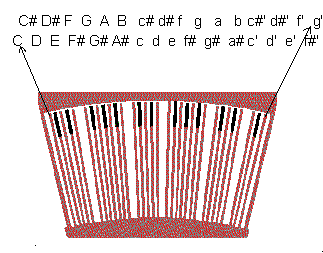
It is possible through a process of either mechanical transmission or electrical switching to use the same rank of pipes to provide a stop for a 4' Principal. With the 4' stop on, low C on the keyboard would play the thirteenth pipe, a pipe that is approximately four feet in speaking length sounding c. The last pipe would be sounded by the G in the second octave of the keyboard, and the final twelve keys would have no pipes to sound, as illustrated in this diagram:
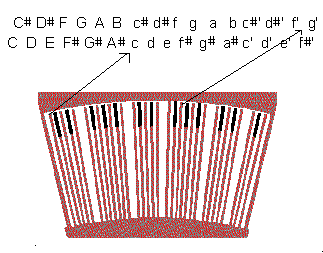
In order that the upper octave of the keyboard can actually sound the pitches it should on the 4' stop, the rank must have twelve additional pipes, as illustrated below. Red lines connect the extreme keys to C and g' of the extended rank, those pipes that sound when the 8' stop is played. Blue lines connect the same keys to c and g", sounded at the extremes of the keyboard by the 4' stop. The first twelve pipes of the rank are used by the 8' stop only, the last twelve by the 4' stop only. The remainder of the rank - - the twenty pipes from c through g' - - are shared by the two stops.
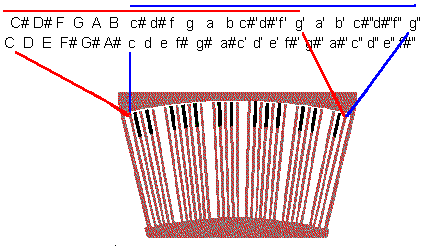
If two stops of adjacent pitch levels (e.g., 16' and 8', or 8' and 4') are derived from a single rank of pipes, it is necessary to add twelve pipes to the rank. In these cases, a pedal rank on a typical organ in the United States will have 44 rather than 32 pipes, a manual rank 73 rather than 61 pipes. If additional stops of adjacent pitches (16', 8', and 4') are derived from a single rank, twelve pipes must be added for each additional octave. The process can be carried further, so that some unit organs have ranks of 109 pipes, playing at 16',8',4', 2' and 1' pitches.
Both mechanical and electrical processes that are used to provide duplex action of any kind can be adapted to the process of extension of ranks to play at different pitch levels. In practice, this is rarely done with mechanical actions and pallet and slider chests, but is not uncommon in various types of electrical actions.
Extension is used when it is desirable to limit the number of pipes in an organ. There are two reasons for doing this:
However, extension presents additional problems in an organ that employs the process.
| GREAT (Manual I) | POSITIV (Manual II) | PEDAL . |
||||||
|---|---|---|---|---|---|---|---|---|
| 8' | Gemshorn | 8' | Bourdon | 16' | Bourdon | |||
| 8' | Bourdon | 4' | Gemshorn | 8' | Gemshorn | |||
| 4' | Principal | 2' | Principal | 8' | Bourdon | |||
| 4' | Bourdon | 1 1/3' | Quint | 4' | Principal | |||
| 2 2/3' | Quint | 1' | Bourdon | 4' | Bourdon | |||
| 2' | Gemshorn | Mixture II | ||||||
| Mixture II | ||||||||
An analysis of the way an instrument such as this one derives its stops is commonly represented in this way:
© 1998 James H. Cook